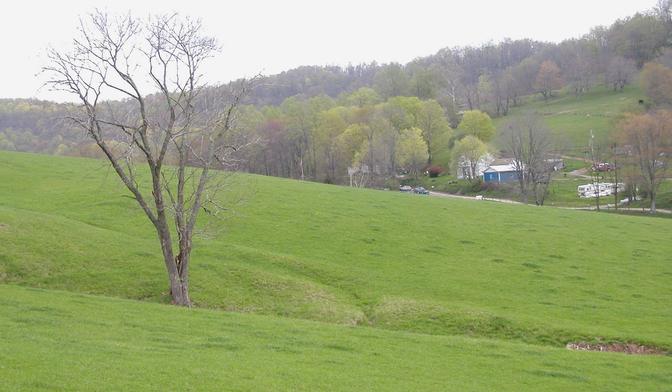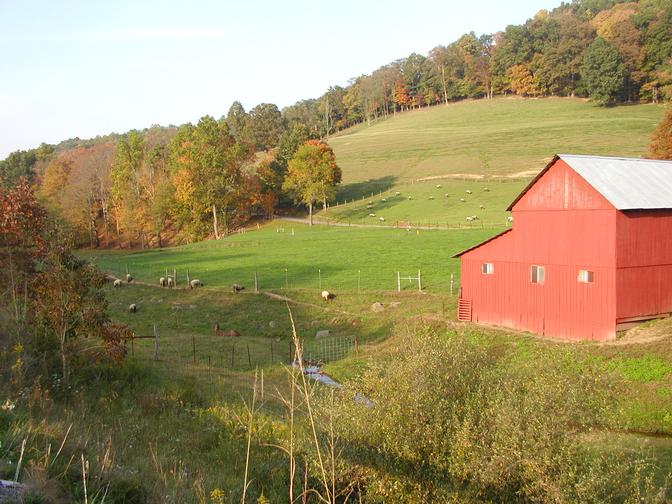
| Next Chapter | Previous Chapter | |
| Chapter 3: Earliest Memories: 2. Horses and the Tractor | Contents | Chapter 1: Prospect |
Among my earliest memories is feeding pet lambs. Dad kept sheep and sometimes a ewe would die or would not own one of her twin lambs. You could buy rubber nipples, either red or black, that would fit a "pop" bottle, and one of the jobs for a small child was feeding lambs. Mom would warm cows milk, put it in a bottle and I would take it out to feed the lambs. Somewhere there is a picture of me about two or three years old feeding a lamb, dressed in coveralls and a knit cap. When I was a little older I could feed two at a time, one with each hand, but the lambs butt the bottle so hard a really little kid could get knocked down.
Sheep were an important part of our family enterprise. Dad knew that you could keep a sheep and a cow in space that would support a cow - the sheep eats plants that cows will not touch. They paid very well since no extra land was required, but you had to have high quality forage in winter, they had to be kept in the barn in bad weather, and had to be protected from dogs. Dad had pure red clover for them to eat in the barn, usually on the side with smaller capacity, to keep it separate. In the winter lambing season Dad would visit the barn several times during the day, and two or three times at night. Many of the ewes had to be "helped" to have a lamb.
These were hard times: late thirties and forties. A lot of people kept a dog, or would take in a stray but they weren't feed well. If things got really bad they just stopped feeding them, and the starving dogs would go miles to find something to eat. There were few or no deer, no turkey, and very little of any other kind of game, because many men hunted a lot for their families. Many of the dogs that got in our sheep came from Mount Clare. They followed the ridge for about three miles. Dad would shoot them when he could (he was a reasonably good marksman), of course. He swore that they could get back to Mount Clare before he could get there in a truck or car. Many of them he knew "personally."
I remember when I was very young Mr. Arthur Sheets came to the barn. He was a very tall, strong man who lived across the valley, behind South Harrison High School where the Stutler-Richards family now lives. He kept sheep, too. He was an excellent marksman. The neighbors said he would hear the dogs running his sheep off the hill and would go out on the porch and shoot the dogs as they ran the sheep down the hill into the area of the house.
(Illustration 2-1)

Appalachian spring
A few times we visited the Sheets house, and we kids played with Mary Ann Sheet's toys, which her parents kept, even though she had married and left home decades before. I remember a set of large antique blocks. They were about three inches on a side, with two sides ornately carved with a letter from the alphabet in the center, and printed pictures on the other sides. Our blocks were about half as long on a side. There was an old locomotive, pressed out of steel sheet, painted the gray natural color of steam locomotives. There were also green ceramic tiles about 1/2 by 2 by 6 inches left over from the mantle place in the front room which served as building toys. (Mary Ann married Edwin Jean Lowther, of Salem, and both are now gone.)
When I got older I helped go after the dogs, and that is about the only shooting "sport" I ever did, except for dogs from McWhorter on the Jesse Run farm in my middle years.
Sheep are very hard to keep from going through fences. You have to be very careful to keep barbed wire close together near the ground, and tight. The wool helps them get through with minimal scratches. Scratches are very bad for sheep in warm weather, because the flies "blow" the sheep (lay eggs in the wounds), and this causes maggots that putrefy the flesh and itch or pain the sheep. If it goes too long the sheep will be killed. You have this problem with cattle, too, but it is not as common as with sheep.
One day when the first stripping (done by L. E. Cleghorn) was going on on the hill, Mom and I, and possibly the sisters, were out in the yard when we heard "fire in the hole" come rolling off the hill. They always called this out three times, with an interval between to warn anyone who might be near and give them time to get out of the way before the explosion. We turned to watch, and there was a great arching of huge rocks over the "spoil pile" and down into the "sugar camp." A tremendous cloud of brown smoke settled down over the sugar camp and the meadow below it - dinitrogen tetraoxide, the gas given off when dynamite explodes. Mom was worried about Dad, because she did not know where he was, but he came running out of the barn almost instantly. I never saw him so angry.
He came to the house and told us he was going up to the sugar camp, it was midday and the sheep were accustomed to resting in that area in midday. Sheep being sheep, if one was there, they all would be there. Before the dust and smoke had settled he was at the spot looking for them. As I remember, there were only two or three killed out of the flock of 25 or so. The man loading the horizontal holes had not noticed that the new dynamite was 50 strength, rather than the 30 strength he was used to. The coal company paid for the sheep. Some of the rocks were three feet in diameter, and they laid there for many years. Since they were shale, eventually they weathered away.
(Illustration 2-2)

A West Virginia sheep farm today
Some of the best pasture on the farm was above the strip job, just over a limestone layer (that's where the best blackberries grew, too). The sheep and cattle could go up there when they wanted. One day they sent word down from the strip that a sheep had gotten over the hill above the "high wall" and couldn't get back. Dad took a hay rope and went up above the high wall with one of the men working there, let himself down some four or five feet on a piece of surface that had slipped so low the sheep couldn't get back up by herself. Then he put her back up, risking life and limb to save her.
One night when I was in college we were next door at Aunt Lotta's for a meal just at dark. After the meal I went outside and saw a fire on the hill, about the middle of the ridge. With binoculars I could see there were people around it. Dad and I decided to get guns and go up to see what was going on, because it certainly was an unusual event. He went up to the right, up the regular road to the level above the strip, and I went to the left, up the pipeline right of way, which was steeper. It was a pretty hard grind to get up there, especially for Dad.
There was a bunch of kids around the fire 10 years old up to 16 or 17, none of whom I was familiar with. So help me, they were joking about eating sheep. There wasn't a sheep in sight, but I got pretty excited. When I was sure Dad was present I went in from one side and he from the other.
These guys became very apologetic and scared. Ricky Bartlett, Troy's son (Troy was the man who did Dad's welding) came up to me and said, "I'm Ricky Bartlett, don't you know me?" I didn't at first, but finally, after he really panicked, I did. Ricky had assumed the responsibility for asking for the West Milford Boy Scout Troop to camp on the ridge that night, and then had neglected to ask. I think both sides learned a lesson, but fortunately both sides had enough self-discipline so there wasn't a disaster.
A sheep will provide a lamb each year, and a fleece. Dad didn't shear but always got someone else. It was a hot, greasy job, due to the lanolin in the fleece. Considerable skill was needed to avoid cutting the sheep, which wiggled a lot. The fleece from each sheep was tied up with a special twisted paper cord that didn't contaminate the wool with other fiber, and put in a huge burlap bag, possibly three feet by six when laid out. It was sold through the "cooperative," something managed by the government agriculture people. The cooperative had greater bargaining power. I suspect now that it simply collected the wool for the buyer and took his price, which was doubtless better than the individual farmer could do himself because of the
The buck was the principal hazard for kids. You had to watch out for him when you went through any field he was in. The ewes would mostly leave you alone. If a strong adult, like Dad, got hit he could break a leg back at the knee (worst case), but he was a real hazard for kids. Many times I went through the barn lot looking more at the buck than the ground. It was a horse that was later my nemesis, though.
Aside A sign of our times: my granddaughter, Eva Beth, could select a video, put it in the player and turn it on, and turn on the TV, by the time she was two.
| Next Chapter | Previous Chapter | |
| Chapter 3: Earliest Memories: 2. Horses and the Tractor | Contents | Chapter 1: Prospect |
Copyright © 1998, 2006, 2008, 2011 S. Tom Bond (stombond at hughes.net)